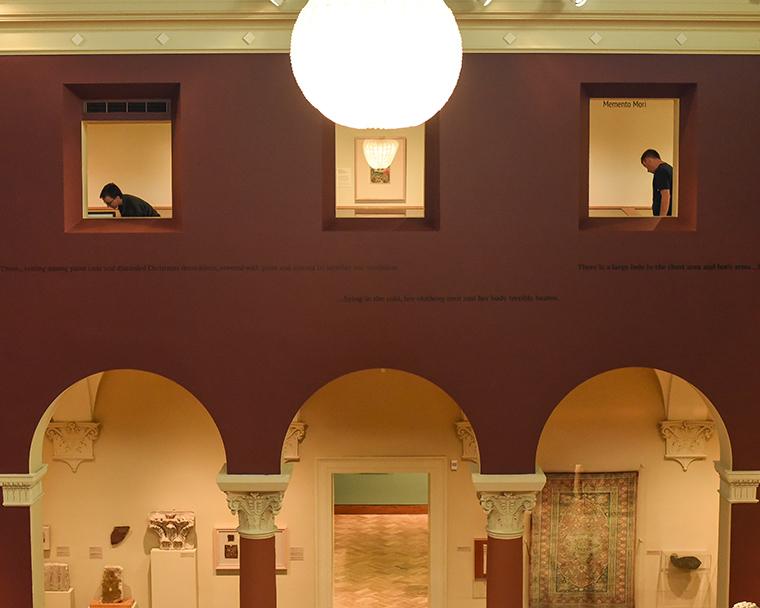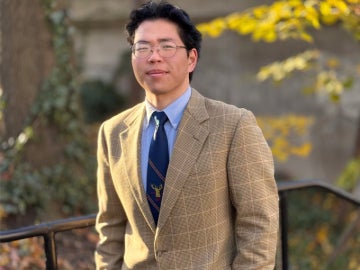Contemplating 'Time'
September 19, 2016
Justine Goode

Students walk around the Ripin Gallery, where curator Andaleeb Badiee Banta’s exhibition "Time Well Spent: Art and Temporality" is currently on display.
Photo credit: William Bradford
For college students, time is of the essence. There never seems to be enough of it: between classes, studying, working multiple jobs, and spending time with friends, students are often left wishing they could stop the clock for just a few hours. They’re also constantly told that these four years are the “best of their lives" — to enjoy it before it passes by all too quickly, and to make the most of the semesters they have left. So perhaps it is particularly fitting that “Time” is the theme for the 2016-2017 academic year at the Allen Memorial Art Museum (AMAM).
The AMAM has used themes such as “Ritual, Religion, and Performance,” “Realism,” “The Americas,” and “The Body” to link its various exhibitions since 2012. This conceptual approach to a year’s programming helps tie together the exhibitions organized by its three curators, who specialize in vastly different types of art. Unlike its predecessors, however, “Time” was selected specifically with the current academic year in mind. As John G. W. Cowles Director Andria Derstine explained, this year’s theme is meant to foreshadow the AMAM’s upcoming centennial celebration in 2017: “It seemed appropriate that the year leading up to that would focus on the concept of time, because we’d been thinking as a staff so much about the centennial and how we’re going to celebrate that,” Derstine says. “The theme was broad enough to allow a lot of different ways of thinking about it—there’s the very present, there’s history and historical aspect of time, there’s a lot of really interesting themes Andaleeb [Badiee Banta] has brought out in her show in the Ripin Gallery.”
Banta, the curator of European and American art, organized the exhibition “Time Well Spent: Art and Temporality” with the help of Juliet Vincente ’16, Laura Baudot, associate professor of English, and Alberto Zambenedetti, visiting assistant professor of cinema studies. The exhibition examines how we perceive and define time, using subcategories such as “Momento Mori,” “Absence and Loss,” “Time and the Elements,” and “Measuring Time” to delineate the many ways we document its passage. The majority of the works on display are drawn from the AMAM’s collection, including the recent acquisition “Still Life with Skull, Pocket Watch, and Roses” (ca. 1650) by Matthieu Platt-Montagne, which has become the representative image of the show. “We didn’t have an older momento mori in the collection,” explains Banta, who acquired the work expressly for the exhibition. By displaying this 17th century work next to a vivid photograph of a rainbow sprinkle-encrusted skull (a 2007 work by Jim Riswold entitled “Make Believe Damien Hirst For The Love Of God”), Banta illuminates the “humor in the ways artists have dealt with the concept of death.” Other artists represented in the exhibition include Andy Warhol, Jim Dine, Willie Cole, and Robert Rauschenberg.
“Conversations: Past and Present in Asia and America,” on display in the Stern Gallery, draws attention to artistic and temporal links between various cultures and time periods. Organized by Kevin R.E. Greenwood, Joan L. Danforth Curator of Asian Art, the exhibition cleverly juxtaposes works that were made in similar artistic traditions, yet are separated by decades and even centuries. For example, two large scrolls covered in delicate calligraphy appear astoundingly similar to the untrained eye; however, after looking more closely at the labels, visitors will find that one scroll is an epic Chinese poem from the 18th century, while the other is an homage to the American folk singer Woody Guthrie, created in 2009. Similarly, the two squat ceramic pots in a corner look like a natural pair—as it happens, one was created in the early 2000s, while the other dates back to the 7th or 8th century. “In East Asia specifically, there’s this very tight relationship to the past,” says Greenwood. “At least traditionally, there is a very respectful, almost worshipful view of the traditions and the great masters of the past. And within the major tradition of Chinese art, known as the literati tradition, copying the styles and the compositions and the subjects of past artists were part and parcel of that tradition. But I wanted to branch out and see what other relationships exist with the past, not only with East Asian artists, but also contemporary artists, and American contemporary artists, who were responding to Asian art.” The works featured in “Conversations” will rotate during the spring semester.
Denise Birkhofer, Ellen Johnson '33 Curator of Modern and Contemporary Art, did not plan for her exhibitions—two separate installations by the renowned artist Fred Wilson—to directly engage with the theme of “Time.” “I wanted to work with a living artist and with our collection,” Birkhofer says, “so inviting an artist to work with our collection seemed like killing two birds with one stone, especially because the Allen’s collection is so strong.” Wilson, who is the recipient of a MacArthur “Genius” grant (1999) and has represented the United States at the Venice Biennale, is known for his site-specific installations in which he “mines” a museum’s collection in order to unearth lost histories and challenge the dominant narratives usually put forth by traditional museum practices. At Oberlin, Wilson has reached into the AMAM’s vault and drawn out the story of Edmonia Lewis, an African American artist who briefly attended the college before becoming a respected neoclassical sculptor, for the installation “Wildfire Test Pit”. Using a mixture of plaster casts, African sculptures, and African American paintings, as well as two carefully placed telescopes, Wilson invites viewers to “challenge artistic and scholarly perceptions of what and who are important to be remembered.”
Time Well Spent: Art and Temporality runs through December 23, 2016. Conversations: Past and Present in Asia and America will be open through May 21, 2017, and Wildfire Test Pit and Fred Wilson: Black to the Powers of Ten will run through June 12, 2017.
You may also like…
Learning by Teaching: Oberlin Students Share Global Music with Young Learners
College and Conservatory students in PACE 103 prepare local children for an immersive community concert at Oberlin.
Nuiko Wadden ’02 Joins Oberlin Conservatory Faculty as Assistant Professor of Harp
The versatile musician brings extensive opera, orchestral, and contemporary music experience to her role
Leo Hidy ’23 Earns 2026 Marshall Scholarship
Leo Hidy ’23, a comparative American studies major who also studied business and economics while at Oberlin, has received a 2026 Marshall Scholarship that will fund two years of graduate study in the UK.


